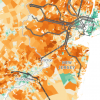Transportation Funding
How and where we invest in our transportation infrastructure has a major impact on growth and development patterns in the state.
Expanding roads and highways often leads to low-density auto-oriented development in suburban and exurban areas, while investing in mass transit in already developed communities can lead to urban revitalization and redevelopment — as has happened, for example, along the Hudson-Bergen Light Rail line. In general, New Jersey Future supports the maintenance of existing infrastructure over expanding capacity (a policy known as fix-it-first), as well as an equitable distribution of funding between roads and alternative forms of transportation such as mass transit and bicycle and pedestrian infrastructure. New Jersey Future is also a strong supporter of “Complete Streets,” a policy that calls for accommodating all users, not just drivers, when designing a new road or retrofitting an old one.

Municipalities face a tricky balancing act when it comes to infrastructure improvements: they need to address large, costly projects but have limited resources to fund them. Historically, issuing debt has been the primary means that municipalities are left with to finance critical improvements. However, municipal leaders are reluctant to be the ones responsible for issuing debt, while utilities and public systems are often hesitant to raise rates to cover project costs.

Simple, small-scale transportation features make a community a safer, healthier, and more affordable place to get around. In a community that values street safety, crosswalks are clearly marked and strategically placed to ensure easy and safe passage for pedestrians.

The Infrastructure Investment and Jobs Act (IIJA) was signed into law by President Joe Biden on November 15, 2021, investing $1.2 trillion in America’s infrastructure. From the IIJA, New Jersey municipal, county, and state governments have the opportunity to tap into once-in-a-generation funding programs, many of which support safe and accessible transportation alternatives for walkers, bikers and rollers.

“Every decision about transportation is an opportunity to build a clean, healthy, and more prosperous future,” declared Christopher Coes, Assistant Secretary, U.S. Department of Transportation (DOT) as he provided prepared remarks to open the session “Delivering Walk-Bike-Ride Transportation in New Jersey” at the 2023 Planning and Redevelopment Conference co-hosted by the NJ Chapter of the American Planning Association and New Jersey Future.

Electric vehicles are great, but they won’t reduce greenhouse gas (GHG) emissions in the transportation sector fast enough, nor will they do anything to alleviate congestion. This past October, the United Nations published the Emissions Gap Report 2022, declaring that an important action for the transportation sector is to “integrate land use and transportation planning to prioritize public transit over private automobiles.”

In this report, New Jersey Future and Smart Growth America analyzed per-capita road usage. The results show that places with the highest activity density have the lowest per-capita usage, suggesting per-capita road-maintenance costs can be reduced by even marginal increases in density. November 2015.

New Jersey has 243 transit facilities, ranging from small single-track stations to major multi-line hubs. The unique characteristics of each station, of its immediate neighborhood, and of its surrounding municipality mean that a wide variety of development strategies should be brought to bear in order to maximize each location’s potential. This report shows how data assembled by New Jersey Future can be used to make decisions on how to target various kinds of transit-oriented development efforts. September 2012.

An assessment of how comprehensively New Jersey’s Department of Transportation has implemented its Complete Streets Policy. September 2011.

2014 Smart Growth Awards: Study identifies land use changes and transportation improvements to spur growth for Somerset County.
See all New Jersey Future Blog posts and articles in this category »
Reports, Presentations and Testimony
- 05/09/2019: Letter to New Jersey Legislators on Increased Funding for NJ Transit in State Budget
- New Jersey Future 2017 Gubernatorial Platform
- fiscal-implications-roads-in-new-jersey
- Social Innovation and Smart Growth 9-13 (Intern Report)
- 10/01/2012 Final NJ_MAP-21_letter
- NJ Transit RFQ for Parking Concession 10-10
- ARC Information Sheet 9-10
- Monmouth University Poll
- Presentation: Re-Funding Transportation Trust Fund 05-11











